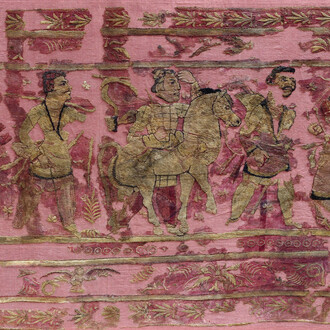[...] When I paint I do not think of structure or theme; what I seek is a certain “flavour” – a rhythm of spirit and energy, so that the soul drifts in the painting, like a shadow of the mind. Everything is flat and calm. “Form” is unimportant. [...]1.
Galerie Urs Meile is pleased to announce the first solo exhibition of Qiu Shihua (b. 1940 in Zizhong, China) at Rämistrasse.
Qiu Shihua’s seemingly monochromatic landscapes reveal themselves only through direct encounter with the original—through presence, through careful and prolonged observation. And yet, even as they begin to appear, they seem to slip away again, resisting clear perception. Emergence and disappearance form the threshold through which these works are approached, rendering the habitual, trained process of motif recognition redundant. Though similar in appearance, each painting resists, in its own way, the fast-paced visual consumption so typical of our time. Instead, they demand a slowing down—a moment of stillness that calls for focus, contemplation, and patience.
Layer by layer, Qiu Shihua applies pigment—barely diluted with oil—onto the canvas, allowing the contours of inner landscapes to emerge. These landscapes are not depictions in the traditional sense, but rather expressions of a meditative process, shaped by his Daoist practice. Emerging and dissolving in equal measure, the motifs arise from a space where memory and a mind emptied through meditation converge. In their quiet presence, they bear witness to the artist’s ongoing journey along the Way of the Dao.
Qiu Shihua is considered a phenomenon in the contemporary art scene: training in the style of Socialist Realism, interest in various French and German styles, finally a formative stay in Paris in the 1980s.. Growing up in dire poverty in southwestern China, it initially seemed unlikely that he would become a contemporary artist.
Despite the external circumstances, painting became a refuge for him at a young age, initially without formal academic training. Qiu Shihua’s paintings are not to be understood in the traditional sense of the word. They are a reflection of his life experiences, a product of his deep meditation, and a refuge from the struggles that have marked his existence. In a world increasingly influenced by market-driven art production and streamlined art education, Qiu Shihua’s work stands as a symbol of detachment from these trends and serves as a reminder of the enduring power of art as a sanctuary. His paintings challenge our perceptions and beckon us to contemplate a different dimension of art— one that transcends time, defies classification, and ultimately becomes a refuge for the artist and the audience alike. His legacy lies in his unwavering commitment to the original idea of art as a refuge, even in a contemporary world presumably detached from its roots.
Notes
1 Qiu Shi-hua, Qiu Shi-hua on the art of painting, exhibition leaflet, Chang Tsong-Zung, 1st ed., Hanart TZ, 1995.














